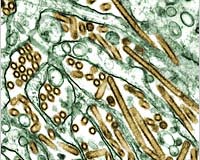| . |  |
. |
Washington DC (SPX) Jun 09, 2010 Scientists using tiny particles of genetic material to interfere in the replication process of the deadly Ebola virus have successfully prevented monkeys exposed to that virus from dying of hemorrhagic fever. The proof-of-concept study, published in this week's issue of The Lancet, suggests that such protection also should be possible in humans. "Over the past decade, we have evaluated numerous therapeutic approaches for the treatment of lethal viruses, such as Ebola," said co-author Dr. Lisa E. Hensley of the U.S. Army Medical Research Institute of Infectious Diseases (USAMRIID). "None of them have conferred complete protection to Ebola virus-infected primates-until now." Using particles called small interfering RNAs (siRNAs), the authors targeted a protein (called the L protein) that is essential for Ebola virus replication. RNA inhibitors, as they are commonly called, are based on a natural gene silencing mechanism used by all cells, and RNAi therapeutics rely on a delivery technology to be effective. Lipid nanoparticles (LNPs) are the most widely used siRNA delivery approaches. In this study, the research team used a proprietary technology called SNALP, or stable nucleic acid-lipid particles, to deliver the therapeutics to disease sites in animal models infected with the Zaire strain of Ebola virus (ZEBOV). A group of three rhesus macaques was given anti-ZEBOV siRNAs intravenously, 30 minutes after exposure to the virus, and again on days 1, 3, and 5. A second group of four macaques was given the treatment after 30 minutes, and on days 1, 2, 3, 4, 5, and 6, after challenge with ZEBOV. Two of the three animals in the first group (which received four post-exposure treatments) were protected from lethal ZEBOV infection and survived. All four of the monkeys given seven post-exposure treatments were protected. The treatment regimen in the second study was well tolerated, with minor changes in liver enzymes that might have been related to viral infection. The study represents the first demonstration of complete protection against a lethal human infectious disease in nonhuman primates using RNAi, according to lead author Dr. Thomas W. Geisbert of the Boston University School of Medicine. "We believe this work justifies the immediate development of Ebola SNALP as a countermeasure to treat Ebola infected patients, either in outbreaks or accidental laboratory exposures," he said. Ebola virus causes hemorrhagic fever with case fatality rates as high as 80 percent in humans. The virus, which is infectious by aerosol (although more commonly spread through blood and bodily fluids of infected patients), is of concern both as a global health threat and a potential agent of biological warfare or terrorism. Currently there are no available vaccines or therapies, so researchers working with Ebola virus must do so in maximum containment (Biosafety Level 4) laboratories. In these specially designed laboratories, investigators wear positive pressure "space suits" and breathe filtered air as they work, and all laboratory waste streams are sterilized. The SNALP-RNAi therapeutic used in the study was developed by Tekmira Pharmaceuticals Corporation of Vancouver, BC. Previous research showed that these siRNAs completely protected guinea pigs when administered shortly after a lethal dose of ZEBOV was administered. While rodent studies are useful for screening prospective medical countermeasures, they are frequently not useful for prediction of efficacy in the more stringent non-human primate models. Further studies in monkeys would be necessary to refine dosing, toxicology and other issued before the treatment could be licensed for human use. "The significance of this report goes beyond the protection against Ebola virus," said COL John P. Skvorak, commander of USAMRIID. "It also represents the potential for this concept to be applied to other viral infections." Reference: Postexposure protection of non-human primates against a lethal Ebola virus challenge with RNA interference: a proof-of-concept study. Thomas W. Geisbert, Amy C. H. Lee, Marjorie Robbins, Joan B. Geisbert, Anna N. Honko, Vandana Sood, Joshua C. Johnson, Susan de Jong, Iran Tavakoli, Adam Judge, Lisa E. Hensley, Ian MacLachlan. The Lancet: 29 May 2010; 375: 1896-190
Share This Article With Planet Earth
Related Links US Army Medical Research Institute of Infectious Diseases Epidemics on Earth - Bird Flu, HIV/AIDS, Ebola
 WHO head defends management of swine flu pandemic
WHO head defends management of swine flu pandemicGeneva (AFP) June 8, 2010 The head of the World Health Organization on Tuesday defended the agency's handling of the swine flu pandemic, rejecting a top medical journal claims that it was marred by commercial interests. "At no time, not for one second, did commercial interests enter my decision-making," said Margaret Chan, WHO director-general, in a letter sent to the British Medical Journal, following the publicatio ... read more |
|
| The content herein, unless otherwise known to be public domain, are Copyright 1995-2010 - SpaceDaily. AFP and UPI Wire Stories are copyright Agence France-Presse and United Press International. ESA Portal Reports are copyright European Space Agency. All NASA sourced material is public domain. Additional copyrights may apply in whole or part to other bona fide parties. Advertising does not imply endorsement,agreement or approval of any opinions, statements or information provided by SpaceDaily on any Web page published or hosted by SpaceDaily. Privacy Statement |